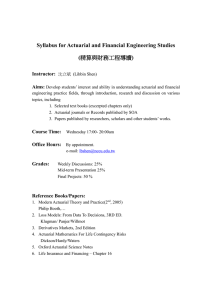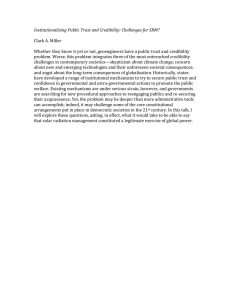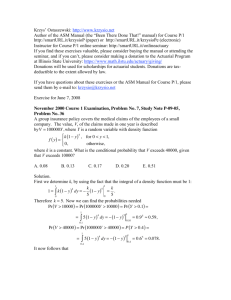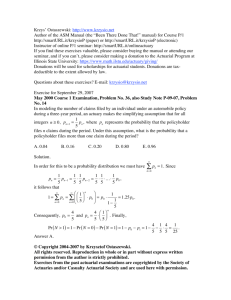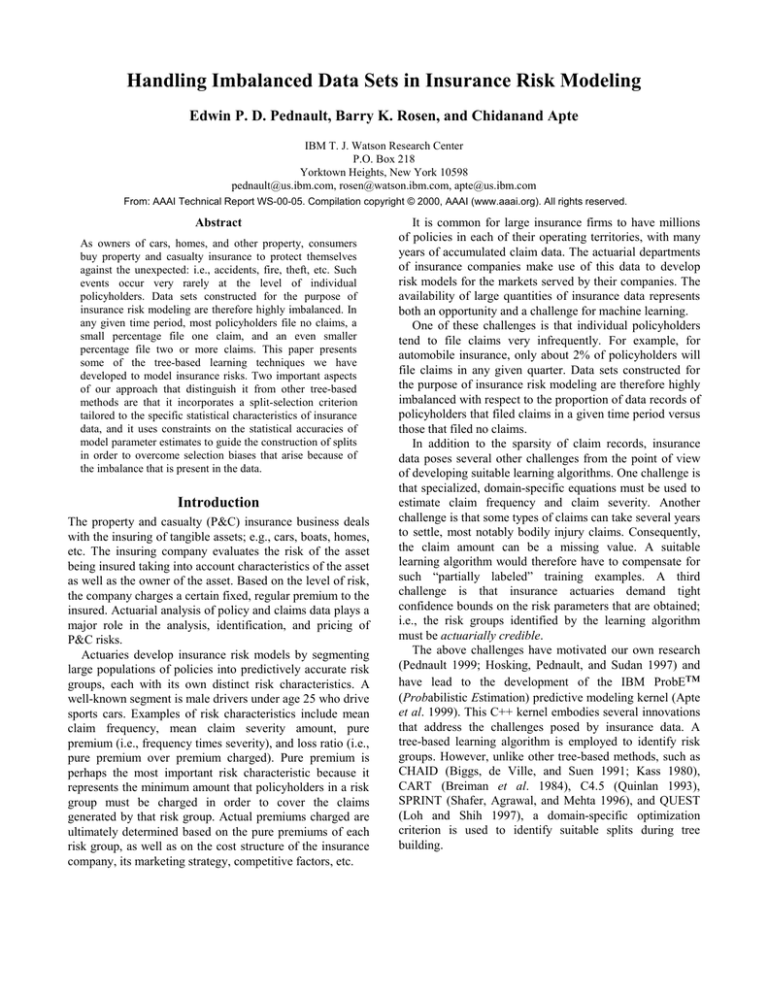
Handling Imbalanced Data Sets in Insurance Risk Modeling
Edwin P. D. Pednault, Barry K. Rosen, and Chidanand Apte
IBM T. J. Watson Research Center
P.O. Box 218
Yorktown Heights, New York 10598
pednault@us.ibm.com, rosen@watson.ibm.com, apte@us.ibm.com
From: AAAI Technical Report WS-00-05. Compilation copyright © 2000, AAAI (www.aaai.org). All rights reserved.
Abstract
As owners of cars, homes, and other property, consumers
buy property and casualty insurance to protect themselves
against the unexpected: i.e., accidents, fire, theft, etc. Such
events occur very rarely at the level of individual
policyholders. Data sets constructed for the purpose of
insurance risk modeling are therefore highly imbalanced. In
any given time period, most policyholders file no claims, a
small percentage file one claim, and an even smaller
percentage file two or more claims. This paper presents
some of the tree-based learning techniques we have
developed to model insurance risks. Two important aspects
of our approach that distinguish it from other tree-based
methods are that it incorporates a split-selection criterion
tailored to the specific statistical characteristics of insurance
data, and it uses constraints on the statistical accuracies of
model parameter estimates to guide the construction of splits
in order to overcome selection biases that arise because of
the imbalance that is present in the data.
Introduction
The property and casualty (P&C) insurance business deals
with the insuring of tangible assets; e.g., cars, boats, homes,
etc. The insuring company evaluates the risk of the asset
being insured taking into account characteristics of the asset
as well as the owner of the asset. Based on the level of risk,
the company charges a certain fixed, regular premium to the
insured. Actuarial analysis of policy and claims data plays a
major role in the analysis, identification, and pricing of
P&C risks.
Actuaries develop insurance risk models by segmenting
large populations of policies into predictively accurate risk
groups, each with its own distinct risk characteristics. A
well-known segment is male drivers under age 25 who drive
sports cars. Examples of risk characteristics include mean
claim frequency, mean claim severity amount, pure
premium (i.e., frequency times severity), and loss ratio (i.e.,
pure premium over premium charged). Pure premium is
perhaps the most important risk characteristic because it
represents the minimum amount that policyholders in a risk
group must be charged in order to cover the claims
generated by that risk group. Actual premiums charged are
ultimately determined based on the pure premiums of each
risk group, as well as on the cost structure of the insurance
company, its marketing strategy, competitive factors, etc.
It is common for large insurance firms to have millions
of policies in each of their operating territories, with many
years of accumulated claim data. The actuarial departments
of insurance companies make use of this data to develop
risk models for the markets served by their companies. The
availability of large quantities of insurance data represents
both an opportunity and a challenge for machine learning.
One of these challenges is that individual policyholders
tend to file claims very infrequently. For example, for
automobile insurance, only about 2% of policyholders will
file claims in any given quarter. Data sets constructed for
the purpose of insurance risk modeling are therefore highly
imbalanced with respect to the proportion of data records of
policyholders that filed claims in a given time period versus
those that filed no claims.
In addition to the sparsity of claim records, insurance
data poses several other challenges from the point of view
of developing suitable learning algorithms. One challenge is
that specialized, domain-specific equations must be used to
estimate claim frequency and claim severity. Another
challenge is that some types of claims can take several years
to settle, most notably bodily injury claims. Consequently,
the claim amount can be a missing value. A suitable
learning algorithm would therefore have to compensate for
such “partially labeled” training examples. A third
challenge is that insurance actuaries demand tight
confidence bounds on the risk parameters that are obtained;
i.e., the risk groups identified by the learning algorithm
must be actuarially credible.
The above challenges have motivated our own research
(Pednault 1999; Hosking, Pednault, and Sudan 1997) and
have lead to the development of the IBM ProbE™
(Probabilistic Estimation) predictive modeling kernel (Apte
et al. 1999). This C++ kernel embodies several innovations
that address the challenges posed by insurance data. A
tree-based learning algorithm is employed to identify risk
groups. However, unlike other tree-based methods, such as
CHAID (Biggs, de Ville, and Suen 1991; Kass 1980),
CART (Breiman et al. 1984), C4.5 (Quinlan 1993),
SPRINT (Shafer, Agrawal, and Mehta 1996), and QUEST
(Loh and Shih 1997), a domain-specific optimization
criterion is used to identify suitable splits during tree
building.
The optimization criterion has the effect of assigning
different weights to claim records than to nonclaim records.
This weight imbalance seems to help compensate for the
imbalance in the proportion of claim versus nonclaim
records; however, we have found that the compensating
effect of the optimization criterion does not in and of itself
solve the data set imbalance problem.
Because rare events by definition occur rarely, it is all
too easy to construct splits in which one branch corresponds
to a small subset of the data in which the rare event does not
occur. At first glance, it might appear that progress is being
made. However, the smaller the subset of data one
considers, the higher is the probability that the rare event
will not occur simply by random chance. ProbE ameliorates
the small sample size problem by using constraints on the
statistical accuracies of model parameter estimates to guide
the construction of splits. The constraints eliminate small
splinter groups from consideration because splinter groups
yield inaccurate parameter estimates for rare events. The
constraints further ensure that the resulting risk groups are
actuarially credible.
Top Down Identification of Risk Groups
The traditional method used by actuaries to construct risk
models involves first segmenting the overall population of
policyholders into a collection of risk groups based on a set
of factors, such as age, gender, driving distance to place of
employment, etc. The risk parameters of each group are
then estimated from historical policy and claims data.
Ideally, the resulting risk groups should be homogeneous
with respect to risk; i.e., further subdividing the risk groups
by introducing additional factors should yield substantially
the same risk parameters. Actuaries typically employ a
combination of intuition, guesswork, and trial-and-error
hypothesis testing to identify suitable factors. The human
effort involved is often quite high and good risk models can
take several years to develop and refine.
ProbE replaces manual exploration of potential risk
factors with automated search. Risk groups are identified in
a top-down fashion by a method similar to those employed
in classification and regression tree algorithms (Biggs,
de Ville, and Suen 1991; Breiman et al. 1984; Kass 1980;
Quinlan 1993; Shafer, Agrawal, and Mehta 1996; Loh and
Shih 1997). Starting with an overall population of
policyholders, ProbE recursively divides policyholders into
risk groups by identifying a sequence of factors that
produce the greatest increase in homogeneity within the
subgroups that are produced. The process is continued until
each of the resulting risk groups is either declared to be
homogeneous (via tree pruning) or is too small to be further
subdivided from the point of view of actuarial credibility.
One of the key differences between ProbE and other
classification and regression tree algorithms is that splitting
factors are selected based on statistical models of insurance
risks. In the case of ProbE, a joint Poisson/log-normal
model is used to enable the simultaneous modeling of
frequency and severity, and hence pure premium.
This choice of statistical model was strongly influenced
by the fundamental nature of the claims process. For
property and casualty insurance, the claims process consists
of claims being filed by policyholders at varying points in
time and for varying amounts. In the normal course of
events, wherein claims are not the result of natural disasters
or other widespread catastrophes, loss events that result in
claims (i.e., accidents, fire, theft, etc.) tend to be randomly
distributed in time with no significant pattern to the
occurrence of those events from the point of view of
insurance risk. Policyholders can also file multiple claims
for the same type of loss over the life of a policy. These
properties are the defining characteristics of Poisson
random processes.
In addition to modeling the distribution of claims over
time, the amounts of those claims must also be modeled.
Log-normal distributions were selected for this purpose
based on an examination of actual historical automobile
claims data. The claim amounts were found to have a highly
skewed distribution. Most claims were small in value
relative to the maximum amounts covered by the policies,
but a significant proportion of large claims were also
present. When the claim amounts were log transformed, the
skewness virtually disappeared and the resulting
distribution was found to be highly Gaussian in shape.
These properties are the defining characteristics of
log-normal distributions.
The risk modeling algorithms in ProbE are designed to
model frequency and severity simultaneously using a joint
Poisson/log-normal model. The risk groups that are
identified are therefore homogeneous with respect to pure
premium (i.e., the product of frequency and severity).
Moreover, the joint Poisson/log-normal model explicitly
takes into account the peculiarities of insurance data
discussed in the introduction.
The Joint Poisson/Log-Normal Model
The optimization criterion used to identify splitting factors
is based on the principles of maximum likelihood
estimation. Specifically, the negative log-likelihood of each
data
record
is
calculated
assuming
a
joint
Poisson/log-normal statistical model, and these negative log
likelihoods are then summed to yield the numerical criterion
that is to be optimized. Minimizing this negative
log-likelihood criterion causes splitting factors to be
selected that maximize the likelihood of the observed data
given the joint Poisson/log-normal models of each of the
resulting risk groups.
Historical data for each policy is divided into distinct
time intervals for the purpose of data mining, with one data
record constructed per policy per time interval.
Time-varying risk characteristics are then assumed to
remain constant within each time interval; that is, for all
intents and purposes their values are assumed to change
only from one time interval to the next. The choice of time
scale is dictated by the extent to which this assumption is
appropriate given the type of insurance being considered
and the business practices of the insurer. For convenience,
quarterly intervals will be assumed to help make the
discussion below more concrete, but it should be noted that
monthly or yearly intervals are also possible
Assuming that data is divided into quarterly intervals,
most data records will span entire quarters, but some will
not. In particular, data records that span less than a full
quarter must be created for policies that were initiated or
terminated mid-quarter, or that experienced mid-quarter
changes in their risk characteristics. In the case of the latter,
policy-quarters must be divided into shorter time intervals
so that separate data records are created for each change in
the risk characteristics of a policy. This subdivision must be
performed in order to maintain the assumption that risk
characteristics remain constant within the time intervals
represented by each data record. In particular, subdivision
must occur when claims are filed under a policy in a given
quarter because the filing of a claim can itself be an
indicator of future risk (i.e., the more claims one files, the
more likely one is to file future claims). The actual time
period covered by a database record is the earned exposure
of that record.
For Poisson random processes, the time between claim
events follows an exponential distribution. Moreover, no
matter at what point one starts observing the process, the
time to the next claim event has the same exponential
distribution as the time between claim events. It can further
be shown that the probability density for the total time T
(i.e., the total earned exposure) between k + l claim filings
(where k is the number of settled claims and l is the number
of open claims) is given by
f(T [ k + l) = k+l e −T ,
(1)
where is the claim frequency of the risk group. The
maximum likelihood estimate used by ProbE for the
frequency parameter is thus the same one that is typically
used by actuaries for estimating frequency:
= k + l = Total Number of Claims .
T
Total Earned Exposure
(2)
In the case of claim amounts, the joint probability density
function for the severities s 1 , ..., s k of k settled claims is
given by:
−
f(s 1 , ..., s k ) =
e
k
(log(s i ) − log ) 2
i=1
2" 2log
.
2 " log
k
k
i=1 s i
(3)
The estimates of the mean log severity log and the variance
of the log severity " log are likewise the ones typically used
for log-normal distributions:
log = 1
k
k
log(s ) .
(4)
i
i=1
and
" 2log =
1
k−1
k
log(s ) − i
2
log
.
(5)
i=1
Only fully settled claims are considered when applying
Equations (4) and (5). The severity fields of unsettled
claims are often used to record reserve amounts; i.e., the
money that insurers hold aside to cover pending claims.
Reserve amounts are not actual losses and therefore are not
used to develop models for predicting actual losses.
Negative log-likelihoods are calculated for each database
record in a risk group based on Equations (1) and (3). The
nonconstant terms in the negative log-likelihoods are then
summed and used as the criterion for selecting splitting
factors in the top-down identification of risk groups. The
constant terms do not contribute to the selection of splitting
factors and, hence, are omitted to reduce the amount of
computation.
With constant terms removed, the negative
log-likelihood score for the i'th database record is:
t i ,
"
t i + log log ,
i =
(log(s i ) − log ) 2
" log
+
,
t i + log
2" 2log
non-claim
open claim
settled claim
(6)
where t i is the earned exposure for the i'th record. Note that
the Poisson portion of the model contributes an amount
t i + log(1/) to the score of each claim record and an
amount t i to the score of each nonclaim record. The sum
of these values equals the negative logarithm of
Equation (1). The log-normal portion of the model
contributes nothing to the scores of nonclaim records, and
an amount log(" log ) + (log(s i ) − log ) 2 /(2" 2log ) to the score of
each settled claim record. The sum of these values equals
the negative logarithm of Equation (3) with constant terms
k
log( 2 s i )) removed. In the case of open claim
(i.e., i=1
records, an expected value estimate of the log-normal score
is constructed based on the scores of the settled claim
records. After dropping constant terms from this expected
value estimate, open claim records contribute an amount
log(" log ) to the log-normal portions of their scores.
If the database records for a risk group contain k settled
claims and l open claims, then the sum of the above scores
is given by:
N
=
t
i
" log
+ (k + l) log
i=1
+
1
2" 2log
estimate that has a sufficiently small confidence interval. In
particular, estimated parameter values X must be within a
certain factor r of their true (i.e. expected) values E[X] with
probability at least p:
(7)
k
(log(s i ) − log ) 2 .
i=1
In the above equation, N is the total number of database
records for the risk group, the first k of which are assumed
for convenience to be settled claim records. Equation (7) is
then summed over all risk groups to yield the overall score
of the risk model. The top-down procedure described in the
previous section identifies risk groups by minimizing the
overall score in a stepwise fashion, where each step
involves dividing a larger risk group into two smaller risk
groups so as to reduce the value of the overall score to the
maximum extent possible.
From the point of view of machine learning, the
important thing to note about the above equations is that
insurance-specific quantities such as earned exposure and
claim status enter into both the equations for estimating
model parameters and the equations for selecting splitting
factors. Earned exposure effectively plays the role of a
weighting factor, while claim status plays the role of a
correction factor that adjusts for missing data in one of the
two data fields to be predicted (i.e., the settled claim
amount given that a claim was filed). The equations thus
take into account the peculiarities of insurance data
discussed in the introduction.
Equation (7) essentially replaces the entropy calculations
used in many standard tree-based data mining algorithms. It
should be noted that entropy is, in fact, a special case of
negative log-likelihood. Its calculation need not be
restricted to categorical or Gaussian (least-squares)
distributions.
The
development
of
the
joint
Poisson/log-normal model presented above illustrates the
general methodology one can employ to customize the
splitting criteria of tree-based data mining algorithms to
take into account data characteristics that are peculiar to
specific applications.
Actuarial Credibility
ProbE's top-down modeling procedure is constrained to
produce risk groups that are actuarially credible. In
actuarial science, credibility (Klugman, Panjeer and
Willmot 1998) has to do with the accuracy of the estimated
risk parameters (in this case, frequency, severity, and
ultimately pure premium). Accuracy is measured in terms of
statistical confidence intervals; that is, how far can the
estimated risk parameters deviate from their true values and
with what probability. A fully credible estimate is an
P
X − E[X]
E[X]
> r P p.
(8)
Typical choices of r and p used by actuaries are r = 0.05
and p = 0.9. In other words, X must be within 5% of E[X]
with 90% confidence.
To ensure that actuarially credible risk groups are
constructed, ProbE permits a maximum fractional standard
error to be imposed on the estimated pure premiums of each
risk group. In the process of subdividing larger risk groups
into smaller risk groups, ProbE only considers splitting
factors that yield smaller risk groups that obey this
constraint. Specifically, each risk group must satisfy the
following inequality:
Var[X]
>r ,
E[X]
(9)
where X is the pure premium estimate of the risk group,
E[X] is the expected value of the pure premium, Var[X] is
the variance of the pure premium estimate, and r is the
maximum allowed fractional standard error. If a splitting
factor that satisfies Equation (9) cannot be found for a given
risk group, that risk group is declared to be too small to be
subdivided and no further refinement of the risk group is
performed. Actuarial credibility is ensured by the fact that,
for any pair of values of p and r in Equation (8), there exists
a corresponding value of r for Equation (9) such that
P
X − E[X]
E[X]
> r P p if and only if
Var[X]
>r .
E[X]
In particular, if X is approximately Gaussian and p = 0.9,
then the corresponding value for r as a function of r is
r = r .
(10)
1.645
For a 5% maximum error with 90% confidence, the
corresponding value of r would thus be 0.00304 (i.e.,
3.04%).
When applying the above credibility constraint, the mean
and variance of the pure premium estimate are
approximated by their empirical estimates, which yields the
following approximation:
Var[X]
O
E[X]
2
1 + 1 e " log − 1
k+l k
.
(11)
Note that this fractional standard error varies as a function
of the statistical properties of each risk group. The
determination of when a risk group is too small to be
subdivided is thus context-dependent. The ability to impose
a context-dependent actuarial credibility constraint on the
top-down process by which risk groups are constructed is
another important feature of ProbE that distinguishes it
from all other tree-based modeling methods, such as
CHAID (Biggs, de Ville, and Suen 1991; Kass 1980),
CART (Breiman et al. 1984), C4.5 (Quinlan 1993),
SPRINT (Shafer, Agrawal, and Mehta 1996), and QUEST
(Loh and Shih 1997).
Equation (11) can also be used to obtain a rough estimate
of the amount of data needed to justify a given number of
risk groups. In general, the standard deviation of log
severity tends to be close to one; hence, (exp(" 2log ) − 1) P 1
in most cases. To achieve a 5% maximum error with 90%
confidence, a risk group must therefore cover at least 2,164
claim records, or about 108,200 quarterly records given that
the average quarterly claim frequency for automobile
insurance tends to be about 2%. Multiply 108,200 by the
number of risk groups and it becomes quite evident that a
very large number of quarterly data records must be
considered in order to achieve fully credible results.
Predictive Accuracy
It is important to note that actuarial credibility constraints
are used as a stopping criterion in combination with tree
pruning using a separate holdout set of training data to
estimate generalization error. Traditional pruning methods
do not guarantee actuarial credibility. Likewise, actuarial
credibility constraints do not prevent overfitting in and of
themselves. Pruning and actuarial credibility must be used
together to achieve the objectives of insurance risk
modeling: i.e., maximize predictive accuracy while ensuring
actuarial credibility.
Split Construction
Applying actuarial credibility constraints during split
construction is straightforward when splitting on numerical
and ordinal (i.e., ordered categorical) data fields. One
simply finds the data value that partitions the range of the
field into two subsets such that the credibility constraints
defined by Equations (9) and (11) are satisfied and the sum
of scores given by Equation (7) for the two subsets is
minimized.
Nominal (i.e., purely categorical) data fields are
somewhat trickier to deal with both because of the
combinatorial number of ways of partitioning nominal
values, and because of the potential to overfit when dealing
with imbalanced data sets. The freedom to group
categorical values arbitrarily can exacerbate the small
sample size problem discussed in the introduction.
To address these issues, ProbE incorporates a modified
version of the bottom-up merging technique used in CHAID
(Biggs, de Ville, and Suen 1991; Kass 1980). CHAID
performs a stepwise grouping of categories to form larger
groups, and eventually a split. The computational
complexity is on the order of the square of the number of
categories. We have modified CHAID's basic procedure by
using credibility constraints to restrict the potential merges
that can be performed at each step. In addition, merging
continues until a binary split is constructed, whereas
CHAID employs a stopping criterion that attempts to
identify multiway splits during the merging process.
ProbE's method for splitting nominal data fields proceeds as
follows:
1) For the nominal data field in question, identify the
subsets of the training data that correspond to each
categorical value. These subsets will be referred to as
segments and segments will be associated with their
corresponding categorical values.
2) Merge together all segments for which the number of
claim records is less than a given threshold.
3) If two or more segments remain, then repeatedly select
and merge pairs of segments so as to minimize the sum
of Equation (7) over all resulting segments subject to
the condition that, if at least one segment is not
actuarially credible, then at least one of the segments in
the pair being merged must likewise not be actuarially
credible. Continue the merging process until only two
segments remain.
4) If there are two remaining segments and one of them is
not actuarially credible, then merge the two remaining
segments into a single segment.
Step 1 is the same initial step performed by CHAID. Step 2
has no counterpart in CHAID and is introduced in order to
stabilize the merging process performed in Step 3. The
premerging performed in Step 2 effectively eliminates
spurious segments that are too small to be meaningfully
compared with other segments. As such, it helps avoid the
small sample size problem associated with rare events, such
as claim filings. The threshold in Step 2 should be set as
small as possible, but large enough to yield meaningful
comparisons among pairs of segments in Step 3. The
current default threshold used in ProbE is six claim records.
Steps 3 and 4 form the counterpart to the bottom-up
merging process employed by CHAID. In our method,
however, the process is constrained to always produce
segments that satisfy desired statistical constraints on the
segments (i.e., actuarial credibility constraints in the case of
insurance risk modeling). The credibility constraint in
Step 3 greatly reduces the potential to overfit when
constructing splits for nominal fields with many categorical
values. Note that this algorithm might fail to find a suitable
split, in which case ProbE will not split on the nominal field
in question.
The fact that statistical constraints are applied as an
integral part of the method for constructing splits is a
distinguishing feature of our method. Statistical constraints
are used to guide the construction process itself. By
contrast, other methods, such as CHAID (Biggs, de Ville,
and Suen 1991; Kass 1980), CART (Breiman et al. 1984),
C4.5 (Quinlan 1993), SPRINT (Shafer, Agrawal, and
Mehta 1996), and QUEST (Loh and Shih 1997), apply
corresponding statistical constraints only after splits have
been constructed. A deficiency of this latter approach is that
splits may be constructed that violate the statistical
constraints, causing them to be eliminated from further
consideration, even though it may have been possible to
construct alternate splits that actually do satisfy the desired
constraints.
Discussion
When actuarial credibility constraints and related thresholds
are deactivated, ProbE tends to identify numerous small
splinter groups in the training data that contain
unrealistically few claim records. These splinter groups
yield unreliable estimates of frequency, severity, and,
hence, pure premium. In fact, in one run, one such splinter
group had the lowest pure premium as estimated on both
the training data and the holdout data used for pruning, but
had the highest pure premium as estimated on a separate
test set. When actuarial constraints and related thresholds
are activated so that they then guide the construction of
splits, such erratic behavior is effectively eliminated.
Moreover, in comparison tests that we performed (Apte
et al. 1999), ProbE consistently produced superior risk
models compared to those constructed using SPRINT
(Shafer, Agrawal, and Mehta 1996), the only off-the-shelf
classification and regression tree package available to us
that could handle the data volumes required for this
application. The success we have had with ProbE suggests
that using statistical constraints to guide the construction of
splits is likely to be a worthwhile approach in other
application domains in which imbalanced data sets are
common.
Adapting our split construction method to other domains
requires only that suitable statistical constraints be used in
place of the actuarial credibility constraints and related
thresholds discussed in the previous section. Actuarial
credibility requires that the minority class (i.e., claim
records) be sufficiently well represented in each and every
branch of the tree. This type of constraint might not be
appropriate for all applications. For example, for
classification problems, it is conceivable for classes to
separable at least in some regions of the input space. Rather
than constraining fractional (i.e., relative) standard errors as
is done in actuarial credibility, one might instead impose
constraints on absolute standard errors. The effect in the
case of classification problems would be to allow splits in
which one branch contains no minority classes, but only if
the majority class is sufficiently well represented in order to
satisfy the absolute standard error constraints. Other types
of constraints are also conceivable, and we believe that
using constraints to guide split selection is an idea that is
ripe for further exploration, particularly when dealing with
imbalanced data sets.
References
Apte, C., Grossman, E., Pednault, E. P. D., Rosen, B. K.,
Tipu, F. A., and White, B. 1999. Probabilistic
estimation-based data mining for discovering insurance
risks. IEEE Intelligent Systems 14(6):49-58.
Biggs, D., de Ville, B., and Suen, E. 1991. A method of
choosing multiway partitions for classification and decision
trees. Journal of Applied Statistics 18(1):49-62.
Breiman, L., Friedman, J. H., Olshen, R. A., and Stone, C.
J. 1984. Classification and Regression Trees. New York:
Chapman & Hall.
Hosking, J. R. M., Pednault, E. P. D., and Sudan, M. 1997.
A statistical perspective on data mining. Future Generation
Computer Systems 13:117-134.
Kass, G. V. 1980. An exploratory technique for
investigating large quantities of categorical data. Applied
Statistics 29(2):119-127.
Klugman, S. A., Panjer, H. H., and Willmot, G. E. 1998.
Loss Models: From Data to Decisions. New York: John
Wiley & Sons.
Loh, W.-Y., and Shih, Y.-S. 1997. Split selection methods
for classification trees. Statistica Sinica 7:815-840.
Pednault, E. P. D. 1999. Statistical learning theory. In
Wilson, R. A., and Keil, F. C. eds. The MIT Encyclopedia
of the Cognitive Sceinces, 798-800. Cambridge, Mass.:
MIT Press.
Quinlan, J. R. 1993. C4.5: Programs for Machine
Learning. San Mateo, California: Morgan Kaufmann.
Shafer, J., Agrawal, R., and Mehta, M. 1996. SPRINT: A
scalable parallel classifier for data mining. In Proceedings
of the 22nd International Conference on Very Large
Databases, 544-555. San Mateo, California: Morgan
Kaufmann.


